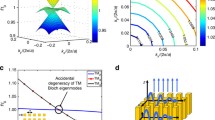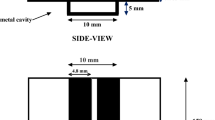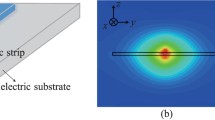Abstract
A dielectric leaky-wave antenna (DLWA) coupled with a metallic diffraction grating is experimentally investigated in millimeter-waves. The interaction between dielectric line and grating is from the narrow-face of dielectric and it is contactless. Measured patterns are compared with simulated ones. The antenna parameters (HPBW, side lobe levels, etc.) are also obtained. The most significant achievement of this antenna is to obtain broadside radiation without any suppression, which occurs due to the periodicity of grating. This situation is not available for the most of the periodic leaky-wave antennas. This antenna type can be used as a broadside radiator by this property as well as a frequency scanning purposes.














Similar content being viewed by others
Notes
Actually, the “peak-to-peak amplitude” of grating is nothing but the “teeth depth” of the grating.
The formulation of the DLWA for broad-face interaction [16] was derived using this approach.
This mode corresponds to the Čherenkov radiation [27] for the case of charged particle-grating interaction. The Čherenkov radiation occurs from the motion of the electrons close to a dielectric.
A similar parametric investigation was also performed for the DLWA coupled with sinusoidal grating for the broad-face interaction in [16].
The same setup and grating sets were also used for the DLWA coupled with sinusoidal grating for the broad-face interaction, which was investigated in [16].
The effect of the coupling distance d between the dielectric waveguide and the sinusoidal grating to the radiation level was investigated for the DLWA coupled with broad-face interaction in [16] and it was shown that this distance has to be chosen as smallest as possible for the highest coupling and to get a high radiation level.
The broadside radiation was approximately the same for the DLWA with broad-face interaction [16] because both antennas are coupled with the same sinusoidal grating (the grating period is the same for both measurement).
The side lobe level of DLWA for the broad-face interaction [16] was 5 dB worse than the DLWA for the narrow-face interaction, which is investigated in this study.
It was polarized in longitidunal direction (z-axis) for DLWA for broad-face interaction [16].
The cross polarization level of DLWA for the broad-face interaction [16] was 5 dB worse than the DLWA coupled with sinusoidal grating for the narrow-face interaction, which is investigated in this study.
HPBW of the DLWA for the broad-face interaction was 6.5° at 31 GHz [16], which is very close to the HPBW of the DLWA coupled with sinusoidal grating for the narrow-face interaction investigated in this study (6.6° at the same frequency). It is expected because both antenna uses the same grating (DPS1)—the aperture is identical for both antennas-.
For the DLWA coupled with DPS2 and DPS3 for broad-face interaction, the -2nd harmonic was appearing in the visible region starting from 31 GHz and 23 GHz, respectively [16]. It means that -2nd harmonics appear in the visible region at 2 GHz lower for DLWA for broad-face interaction. These results show that the radiation behaviors of the harmonics of both antenna types are different.
The results of the parametric investigation show that there is big similarity between the antenna investigated here (DLWA for narrow-face interaction) and the one for broad-face interaction [16]. Thus, the behaviors of the radiation patterns of both antennas do not change by varying the geometrical parameters. However, the measurements have to be done out of the open stop-band region at broadside angles for the DLWA for broad-side interaction [16] due to high attenuation.
The same calibration procedure used in the reference [16] was applied here.
This is excetly the the same rectengular grating, which was used for the DLWA coupled with sinusoidal grating for broad-face interaction [16].
The open stop-band behavior (resonance) was observed for the DLWA for broad-side interaction.
References
S. J. Smith, E. M. Purcell, “Visible light from localized surface charges moving parallel to a reflection grating”, Phys. Rev., 92, 1069 (1953).
T. Itoh, “Application of gratings in a dielectric waveguide for leaky-wave antennas and band-reject filters”, IEEE Trans. Microwave Theo. Tech., MTT-25 (12), 1134–1138 (1977).
T. Itoh, A. S. Hebert, “Simulation study of electronically scannable antennas and tunable filters integrated in a quasi-planar dielectric waveguide”, IEEE Trans. Microwave Theo. Tech., MTT-26 (12), 987–991 (1978).
K. L. Klohn, R. E. Horn, H. Jacobs, and E. Freibergs, “Silicon waveguide frequency scanning linear array antenna,” IEEE Trans. Microwave Theory Tech., MTT-26 (10), 764–773 (1978).
S. Kobayashi, R. Lampe, R. Mittra, and S. Ray, “Dielectric rod leaky-wave antennas for millimeter-wave applications”, IEEE Trans. Antennas Propagat., AP-29 (5), 822–824 (1981).
R. E. Horn, H. Jacobs, E. Freibergs, and K. L. Klohn, “Electronic modulated beam-steerable silicon-waveguide array antenna”, IEEE Trans. Microwave Theory Tech., MTT-28 (6), 647–653 (1980).
T. N. Trinh, R. Mittra, R. J. Paleta, “ Horn image-guide leaky-wave antenna”, IEEE Trans. Microwave Theory Tech., MTT-29 (12), 1310–1314 (1981).
T. Itoh, B. Adelseck, “Trapped image guide leaky-wave antennas for millimeter wave applications”, IEEE Trans. Antennas Propagat., AP-30 (3), 505–509 (1982).
R. Mittra, R. Kastner, “A spectral domain approach for computing the radiation characteristics of a leaky-wave antenna for millimeter waves”, IEEE Trans. Antennas Propagat., AP-29, 652–654 (1981).
M. Guglielmi, A.A. Oliner, “Multimode network description of a planar periodic metal-strip grating at a dielectric interface. I. Rigorous network formulations”, IEEE Trans. Microwave Theo. Techn., 37 (3), 534–541 (1989).
M. Guglielmi, H. Hochstadt, “Multimode network description of a planar periodic metal-strip grating at a dielectric interface. III. Rigorous solution”, IEEE Trans. Microwave Theo. Techn., 37 (5), 902–909 (1989).
M. Guglielmi, G. Boccalone, “A novel theory for dielectric-inset waveguide leaky-wave antennas”, IEEE Trans. Antennas Propagat., 39, 497–504 (1991).
M. Chen, B. Houshmand, T. Itoh, “FDTD analysis of a metal-strip-loaded dielectric leaky-wave antenna”, IEEE Trans. Antennas Propagat., 45 (8), 1294–1301 (1997).
H. D. Yang, D. R. Jackson, “Theory of line-source radiation from a metal-strip grating dielectric-slab structure”, IEEE Trans. Antennas Propagat., 48 (4), 556–564 (2000).
V. Manasson, L. Sadovnik, R. Mino, “MMW scanning antenna”, IEEE Aerospace and Electronic Systems Magazine, 11 (10), 29–33 (1996).
A. O. Salman, “The millimeter wave radiation of a dielectric leaky-wave antenna coupled with a diffraction grating: broad-face interaction”, Journal of Infrared, Millimeter, and Terahertz Waves, publishing.
M. Guglielmi, D. R. Jackson, “Broadside radiation from periodic leaky-wave antennas”, IEEE Trans. Antennas Propagat., 41, 31–37 (1993).
K. Solbach, B. Adelseck, “Dielectric image line leaky-wave antenna for broadside radiation”, Elec. Letters., vol. 19, 16, 640–641 (1983).
A. O. Salman, D. Dibekci , S. Gavrilov, A. Alexei Vertiy “The Millimeter wave Radiation of a Traveling Wave Sinusoidal Thin Wire Antenna”, Int. J. Infrared and Millimeter Waves, 29 (5), 465–485 (2008).
A. O. Salman, D. Dibekci, Sergey P. Gavrilov and Alexey A. Vertiy, “The Radiation Properties of a Novel Wire Antenna for the Security Fence Radar”, IEEE Transactions on Antennas and Propagation, 56 (9), 2852–2864 (2008).
A. O. Salman, H. Cetinkaya, A. A. Vertiy, “Actively and Passively-Excited Sinusoidal Microstrip and PCB Strip Antennas Operating at K And Millimeter-Wave Bands”, Microwave Opt. Technol. Lett., 50 (5), 1302–1308 (2008).
C. H. Walter, Travelling wave antennas, (McGraw-Hill, New York, 1965).
R. C. Johnson, Antenna Engineering Handbook, 3rd edition (The McGraw-Hill Co., 1993).
L. Brillouin, Wave propagation in periodic structures, (McGraw-Hill Book Co., New York, 1946).
R. E. Collin, F. S. Zucker, Antenna Theory-Part 2, chap. 20, (McGraw-Hill Book Co., New York, 1969).
R. Crampagne, L. Padellec and A. Saremejean, “Leaky wave antenna using an inverted strip dielectric waveguide”, 10th European Microwave Conference, (Oct. 1980).
I. Palocz, A.A. Oliner, “ Leaky Space-Charge Waves II—Smith Purcell Radiation”, Proc. IEEE, 55 (1), 46–56 (1967).
R. P. Leavitt, D. E. Wortman, and H. Dropkin, “Millimeter-wave Orotron Oscillation-Part I: Theory,” IEEE Journ. Quant. Electronics, QE-17 (8), 1333–1340 (1981).
D. E. Wortman, H. Dropkin and R. P. Leavitt, “Millimeter-wave Orotron Oscillation-Part II: Experiment” IEEE Journ. Quant. Electronics, QE-17 (8), 1341–1348 (1981).
Acknowledgment
A. O. Salman thanks to H. Cetinkaya for his assistance to HFSS simulations.
Author information
Authors and Affiliations
Corresponding author
Rights and permissions
About this article
Cite this article
Salman, A.O. The Millimeter Wave Radiation of a Dielectric Leaky-Wave Antenna Coupled with a Diffraction Grating for the Broadside Radiation: Narrow-Face Interaction. J Infrared Milli Terahz Waves 31, 1032–1047 (2010). https://doi.org/10.1007/s10762-010-9675-3
Received:
Accepted:
Published:
Issue Date:
DOI: https://doi.org/10.1007/s10762-010-9675-3




